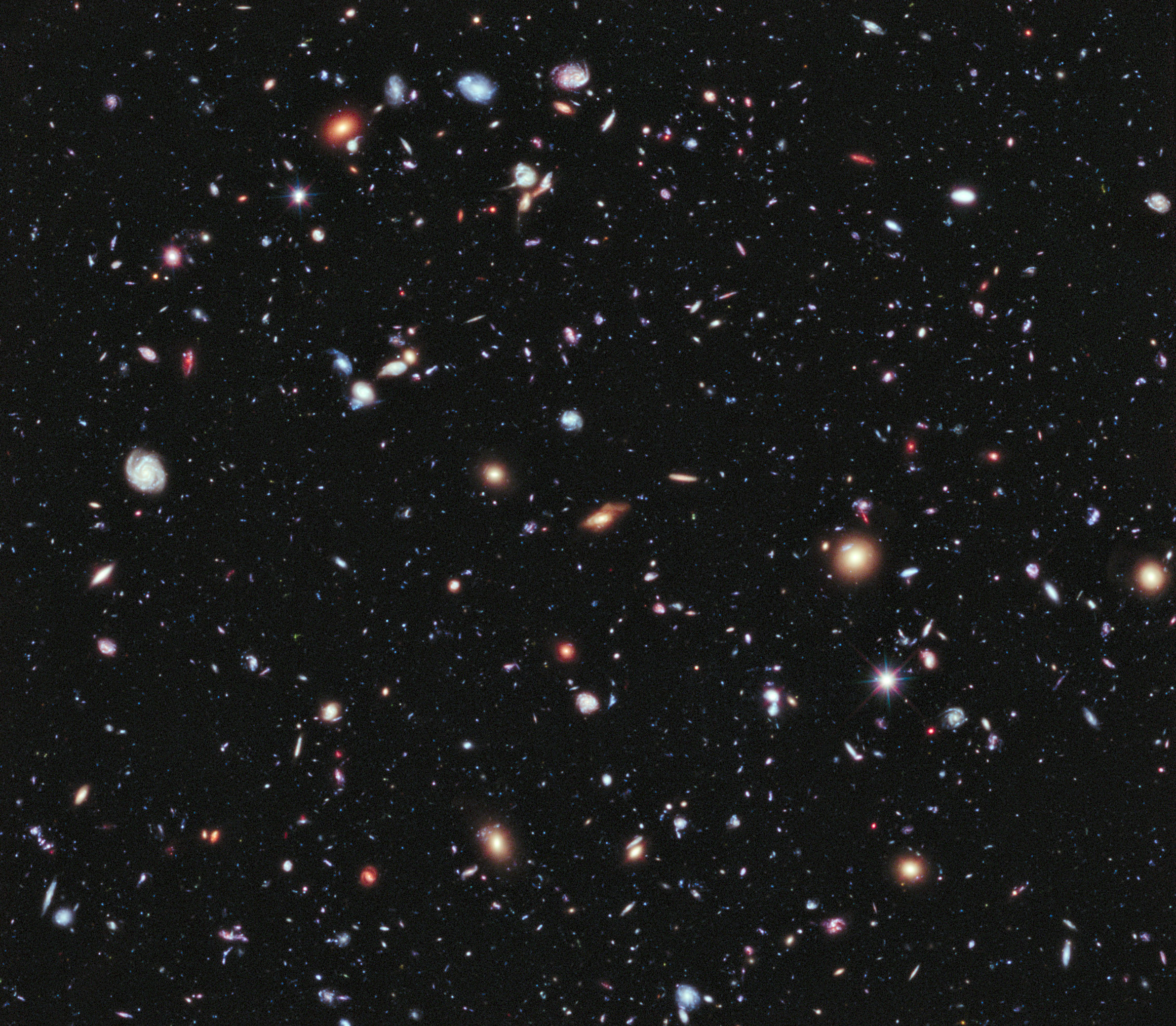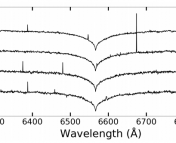Title: A highly magnified star at redshift 6.2
Authors: Brian Welch, Dan Coe, Jose M. Diego, et al. (26 co-authors)
First Author’s Institution: Center for Astrophysical Sciences, Department of Physics and Astronomy, The Johns Hopkins University, Baltimore, MD, USA.A
Status: Published in Nature [closed access]

An incredible fact about the Hubble eXtreme Deep Field shown in Figure 1 above is that almost every single blob of light in the image represents an entirely different galaxy from our own. The few stars that are visible are foreground stars within our own galaxy, the Milky Way. It is extremely challenging to directly observe and resolve individual stars in other galaxies, and only really possible in galaxies relatively close to us . . .
. . . which makes the discovery presented in today’s paper all the more incredible! The authors observed what seems to be an individual star (or a small group of stars) in a galaxy at a redshift of 6.2, or about 28 billion light years away and only 900 million years after the Big Bang! For comparison, the previous record for the farthest individual star observed was at redshift 1.5, or about 14.5 billion light years away and 4 billion years after the Big Bang. Talk about blowing the previous record out of the water!
Cosmic Magnifying Glasses
To understand the process of observing extremely distant objects, one needs to consider gravitational lensing. The challenge of observing galaxies at really high redshift (i.e., at great distances away from us) is that they appear too faint for even our best telescopes, owing to the limited number of photons from these galaxies actually reaching us. Observing them is only possible if they get somehow magnified, and gravitational lensing provides the perfect tool to do so.
Just as matter is affected by gravity, so is the path that light travels on. Light from a distant, background source will get deflected from its original path as it travels through intervening foreground mass before it reaches us – much like an optical lens bends the path of light rays – and what we end up seeing is an image (or multiple images) of the background source. For more on lensing, see astrobites here, here, and here. Lensing can also contribute to magnification (or in some cases, de-magnification) of the source, where the image appears much larger and brighter (or smaller and fainter) than the object itself. This magnification effect is key for observing highly distant objects that would otherwise be too faint for telescopes to detect.
The Morning Star at Cosmic Dawn
By leveraging the power of gravitational lensing and Hubble Space Telescope data, the authors observed the star-like object in a galaxy that is lensed by a massive galaxy cluster. Since its host galaxy lies at redshift z = 6.2, during the epoch known as Cosmic Dawn, they named the star “Earendel”, after a figure associated with the Morning Star from Germanic and Norse mythology as well as J. R. R. Tolkien’s work.
Figure 2 shows an image of their observations. The assorted reddish-orange luminous blobs are galaxies that are members of the foreground galaxy cluster (the system doing the lensing), while the giant red arc running diagonally from bottom left to top right is a distorted image of Earendel’s host galaxy. The loopy red line denotes what is called a “Critical Curve” — an imaginary line connecting points of extremely large (technically infinite) magnification due to the effects of lensing effects. Earendel, denoted in green by “Lensed Star”, lies almost on top of the critical curve (about 0.1 arcsecond offset from it), which indicates that its image must be highly magnified.

To better understand Earendel’s properties as well as other aspects of this system, the authors constructed a number of lens models. A gravitational lens model is a representation of the mass distribution of the system doing the lensing (in this case, the massive foreground galaxy cluster) that allows one to infer important properties of the system like how the magnification varies at different positions. Since the observed gravitationally-lensed image of Earendel does not portray its true brightness and size because of magnification effects, the authors used their lens models to “de-lens” the star’s image. They inferred that it has an intrinsic luminosity corresponding to an absolute magnitude of approximately -10 in the UV part of the spectrum, and a physical size of about 0.1 parsec.
By comparing these constraints on the size and brightness of Earendel with predictions from stellar evolution models, the authors then estimated that Earendel has a mass of at least 50 solar masses with no well-constrained upper limit, making it likely that it is either a high-mass star or an unresolved binary star system. There is also the possibility of it being a cluster of stars instead, but the authors claim that its relatively small size of 0.1 parsec makes it unlikely to be a star cluster, since the smallest known clusters have sizes on the order of 1 parsec.
Numerous Possibilities
Given how much astronomers already know about stellar evolution and just how many stars we’ve already observed over the years, one might question what makes this new discovery so special. Well, for one, the fact that we can even observe what is seemingly a single star as it was almost all the way back at the beginning of the Universe is extraordinarily cool in itself! It is a remarkable demonstration of how far we have come in our abilitiy to probe the very origins of time and space themselves.
There are also a couple of really interesting scientific possibilities that this observation of Earendel brings up:
- It could be a Population III star: these are the (hypothesised) first ever generation of stars in the Universe that formed out of pristine, primordial gas and seeded the first galaxies. They likely lived extremely short lives, and to date we have never directly observed a Pop III star. If Earendel turns out to be one, it would mark an absolute milestone in our understanding of the early Universe!
- It could be a binary system consisting of a stellar-mass black hole accreting a stellar companion. Such objects are still quite poorly understood, and observing one at such an early cosmic time would tell us a lot about when black hole binary systems first started forming.
There is no conclusive evidence, however, pointing to either of the two possibilities above. The authors conclude that follow-up observations with JWST, which is better suited for high-redshift observations than Hubble, would greatly further our understanding of the Earendel system and shed more light on its seemingly unique properties.
Astrobite edited by Sarah Bodansky
Featured image credit: modified from Getty Images and NASA/ESA/STScI





Thank you for a lucid exposition !
Thank you! So glad you enjoyed reading it. 🙂